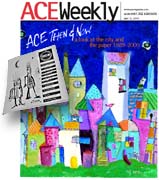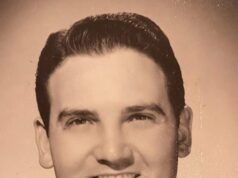Ace 11th Anniversary, May 11, 2000
Ace Then and Now: 1989 and 2000
Don’t know much about history? Hell, we don’t either. That’s why we keep all the ACE archives to prop up our sagging recollections.

And so it was half a score and a couple of years ago when ACE made its big ol’ debut, capturing in those first few years an image of Lexington (or at least a vital segment of it) from the late 80s and early 90s.
The inaugural issue’s cover featured art by Rodney Hatfield, and an interior story “introduced” the longtime Lexington musician to his burgeoning identity as “Art Snake,” identifying him “as an actor…” (based on his speaking debut in that thoughtful thriller Next of Kin starring master thespian Patrick Swayze and pre-Star Wars Liam Neeson). The article mentions the faithful Main Street’s following of the now-semi-defunct Metropolitan Blues All-Stars, and the band’s third appearance on NPR’s Mountain Stage where they were erroneously “billed as a new sound from Mexico, Los Focas Ristas.”
The issue also included a rave review of (now-completely-defunct) Vale of Tears, and a lament on the then-dormant Kentucky Theatre. Jo Ann Circosta observed, “The Kentucky has languished in suspended animation since October 1987, when a fire in the adjacent Fleur de Lys restaurant forced the closing of both establishments. The restaurant moved within a matter of months and is doing a thriving business on Upper Street. [It was supplanted by a succession of restaurants: Joe’s Fleur de Lys, Sine Qua Non, and now Mia’s.] The Kentucky Theatre, however, continues to sit quietly, waiting to be revived, ‘closed temporarily’ being its limp lament.” She concluded, “The Kentucky has been a factor in forming the special ambiance of downtown Lexington. What its contribution will be in the future remains to be seen…”
There’s an ambitious list of “movies we’ve missed,” that includes Tampopo, Swimming to Cambodia, The Thin Blue Line, Babette’s Feast, and Ken Russell’s Lair of the White Worm (which is included twice, once as Liar of the White Work and again as Liar of the White Worm).
Re-reading Circosta’s heartfelt (almost) requiem recalls a particularly dark episode in downtown’s history with a surprisingly happy ending.
The same could not be said of her sadly prescient interview with Mayor Baesler in the Fall 89 (Vol. 1, #3) issue, “Mayor Baesler on the ‘State of the Arts in Lexington.” Asked to predict the future of Lexington’s arts scene, Mayor Baesler foretold, “I’d like to see us have a facility downtown like the Cultural Center that will be outstanding, a museum where you could bring Smithsonian exhibits and things like that… I think that will happen in about four or five years.”
Eleven years later, what we have downtown is cultural center funding expended on things like a (faltering) basketball museum.
But asked “if it was within your power to bring any artistic event to Lexington, what would it be?” Baesler responded, “does Willie Nelson count?” (And lo – in a dare-to-dream moment of greatness – it was so. Nelson has showed up several times in the intervening years. And played in the restored/revitalized Kentucky Theatre.)
In that issue’s editorial, Jennie Leavell recommended Monday Night Expression Sessions at the old High on Rose (a staple of the late 80s/early 90s literary ritual). And Lucinda Masterton Hall reviewed Cafe Max (subsequently replaced by Ed & Fred’s Desert Moon before it relocated to Grand Boulevard, and now occupied by Portofino).
By 1990, the first ACE Picks showed up (Vol. 2, #1). Recommendations included Manon of the Spring (encouraging readers: “Foreign films are not all inaccessible. The characterization of all European films as ‘difficult’ or ‘overly intellectual’ is just as absurd as a generalization that all American films are musicals or gangster movies.” Not that we remember a time when anyone generalized that all American films were musicals – though there was that ill-fated Olivia Newton John Grease-to-Xanadu genre.)
By the Autumn issue of 1990, ACE began publishing an Editorial Credo (apparently lifted – according to various letters from readers over the years – but the source was not credited): “to speak from our hearts and not our pocketbooks, to applaud creativity, to reinforce and embody freedom of expression, to divulge injustices, to defend the defenseless, to respect our heritage, to tell it like it is, to tell it like it ought to be, to illuminate-rejuvenate-educate, to find a rainbow of hope even when it seems mighty bleak, to struggle through challenges all day but end up relaxed at a cozy cafe around dinner time, and to wash the dishes at least once a week.”
In April 1991, the cover reflected the tweaking of the mission – switching from “Arts, Culture and Entertainment from the Bluegrass” to “Arts, Commentary & Entertainment.”
“Events and Messages” began to appear as the early forerunner of what is now The ACE List.
In May 1994, ACE was purchased by Susan Saylor Yeary, Susan Harkins, and Peggy Blythe.
They opened with this statement (which ran alongside a foxy photo of the three of them posed with a big Harley) “As the new publishers of ACE Magazine, we want to invite you to join us as we embark on a grand adventure; encountering all manner of things, people, issues and events that engage, inform, delight, surprise and challenge. Our vehicle is the ACE Magazine we’ve come to depend on over the years. What fuels our travel is the desire to investigate, to learn, and to speak up. ACE returns to the street this month ready to examine the personal responsibility that rests with each of us in regard to sustainable, earth-friendly agriculture. Along the way we find answers from one artist who has found her unique expression in a classic style and vernacular forms, while another leaves us with the question of gender stereotypes and social acceptance. So settle in. Buckle up. And keep an ACE in your face.”
Their first move was a physical one – to downtown. The publishing schedule was immediately expanded from 11 times/year to 12 times. “Arts, Commentary, and Entertainment” was retired from the banner later that year. (Though it refuses to die.)
Yeary bought out the original interests of Blythe and Harkins, and by 1997, the production schedule increased to 20 times per year. The format changed from broadsheet to tabloid size. The cover format switched from black and white to four color. In 1998, ACE got really busy: publication schedule increased to 26 times per year, every-other Wednesday. ACE launched a website at www.acemagazine.com (then aceweekly.com). The paper applied for membership to Association of Alternative Newsweeklies (and was one of five papers to be accepted, out of sixteen applicants).
And here we are today. We’re moving again, at the end of this month (to the corner of Jefferson and Second, across from the old Fish Net, which will soon be Carleton Wing’s gallery, Wingspan). We hope to see the same ongoing revitalization of that neighborhood that we’ve enjoyed observing at N. Limestone.
And we’re expanding again – finally – to our longtime goal of weekly. Look for us every Thursday.
So now we all know a little something about hist-o-ry.








